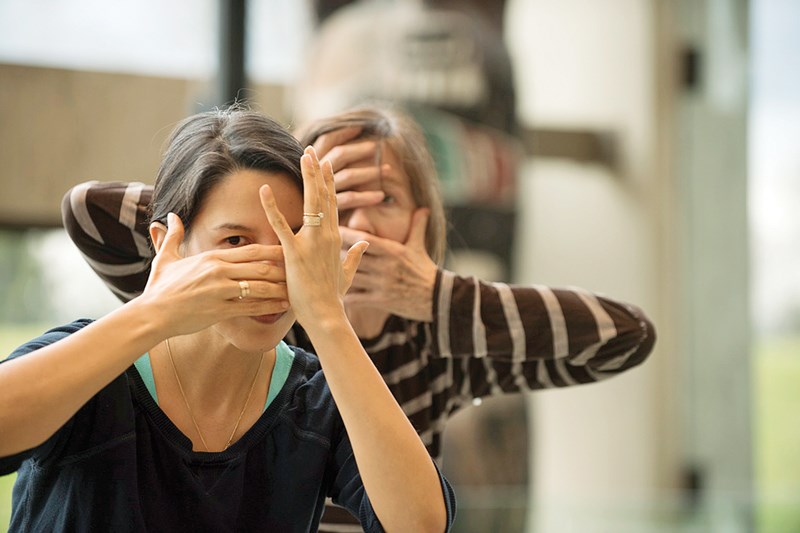Jamieson/Grenier at Woodward’s Production Studio as part of Vancouver International Dance Festival through March 25. For more information visit vidf.ca.
In a fusion of traditional Indigenous and contemporary dance, light breaking broken, shares a story of cross-cultural understanding in a performance that has been years in the making.
Margaret Grenier grew up surrounded by the movements of her ancestors preserved by her parents, Ken and Margaret Harris, who created the Dancers of Damelahamid in the 1960s to restore their cultural traditions.
In light breaking broken, Grenier joins Karen Jamieson – a contemporary choreographer and dancer who has worked in collaboration with the family run company since the ‘90s – to create an interpretation of broken historical narratives and contemporary connections of hope.
The oppression of traditional song and dance through the Potlatch Law forced ceremonies underground and dislocated many from their community and culture, but through those fractures Grenier sees an opportunity for transformation.
“What we were doing in a shared space was looking at both contemporary and indigenous dance practices and seeing where those openings lead to the possibility of relationships,” says Grenier, who explained that Jamieson’s history with her family allowed them the opportunity to meet in the middle in terms of creative collaboration.
The difference Grenier has noticed in her practice since Jamieson first worked with the family is a deeper level of cultural understanding between the two, which allowed them to create this duet.
“That was part of why the exploration side really did take us a few years to develop the material that we were going to work with. It was just two very different processes coming together and figuring our way through that,” she said.
When presenting culturally significant art, the task of communicating a certain message can be a bit tricky, she says. The responsibility to represent a whole or represent something much bigger than oneself can be an intimidating proposition to take on solo.
But Grenier looks at this production as an opportunity to inspire dialogue through lived experience.
“I think the best way to address (the conversation) is just with individuality and what’s beautiful to me with this collaboration is that it doesn’t just have my voice as part of it, it has my parent’s voice also because that’s where the relationship truly started.”
Immersed in the rich heritage provided by her family, Grenier says that as she grew she began to realize the privilege of being surrounded by such vivid illustrations of her culture.
She found the opportunity to experience and learn language, oral narratives, and an understanding of her people’s relationship to land through dance.
“It’s a form of art but it’s also a form of having something tangible, like having something physical that connects you to all of these things; language, land, community.
“I think that’s what shaped my identity. I don’t think my identity would be nearly as strong without it because it can be quite abstract if, in your day-to-day life, it’s something that’s not part of mainstream society. It was really something that helped to shape who I am.”
Confronting difficult topics of conversation about the nation’s relationship with indigenous peoples helps to bring those issues to life, freeing them from fixed conceptions to hopefully, Grenier says, move to a place of understanding.
Through dance she hopes to shake the historical narratives free of their rigidity and encourage an openness to change.
“To me that’s symbolic of the conversation that needs to take place that also needs to come to a deeper level where we understand the relationship between indigenous peoples within B.C.
“The more we spend time there I think the better it’ll be for our children in terms of appreciation of what indigenous art, culture and what our voice can contribute to in a broader sense.”
The Dancers of Damelahamid are firmly rooted in the training passed from the previous generations, but Grenier believes in the importance of being open to modern influences. Through that mindset she has seen the group evolve into a more formalized company, which has allowed them to share their art with a wider audience.
“I think that’s a really important transformation because otherwise it really limits who gets to experience the art form,” Grenier says.
The merging of contemporary dance with indigenous storytelling is a lengthy process, she explained, because it takes an extensive amount of time to arrive at a place of cultural understanding.
Keeping this in mind, this collaboration is a piece of art that is very specific to the relationship between Jamieson and Grenier because of the connection they share and the understanding that dance in this form is an expression of cultural identity.
“I think that longevity and the intergenerational process is so important to being able to move through something to a place of understanding, and I hope that translates when people see it,” says Grenier.
Light breaking broken will be performed through March 25 at 5 p.m. in the Woodwards Production Studio.



